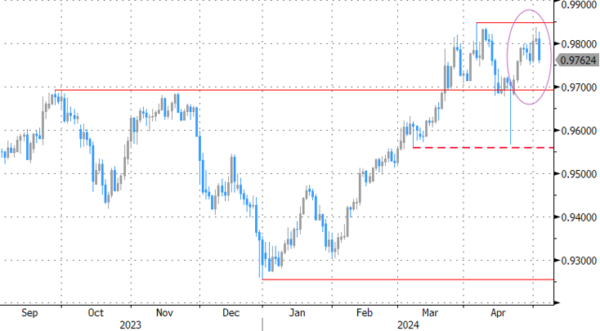Markets
US Treasury yields ease a few more bps in the wake of yesterday’s FOMC policy meeting. Markets were bracing for a hawkish surprise from chair Powell following a string of higher-than-expected inflation readings and ongoing economic resilience. Its absence pushed rates up to 7 bps lower at the front with additional losses of some 2 bps today. The 5% psychological mark in the 2y tenor is being left alone for the time being. Longer maturities swapped minor losses for gains as US investors started joining and going into some second tier eco data that eventually didn’t move any significant barriers. Tomorrow’s services ISM and April payrolls report on the other hand do have the potential to do so. First quarter unit labor costs jumped from 0% in 2023Q4 to 4.7% amid a sharp slowdown in productivity from 3.5% to 0.3%. Initial jobless claims again came on to the strong side of expectations, stabilizing at 208k vs a small uptick to 211k expected. German Bunds slightly outperformed Treasuries in a catch-up move after taking the day off on Wednesday. Rates drop between 0.4 and 1.7 bps across the curve but trade off the intraday lows.
Currency markets are an ocean of calm. The euro loses a few ticks against an equally unconvincing dollar. EUR/USD is testing the 1.07 big figure. The Japanese yen almost fully pared morning losses of a percent or more following an alleged intervention by Japanese officials in late US dealings yesterday. Guestimates amount to JPY 3.5tn on top of the JPY 5.5tn spent Monday. USD/JPY is currently changing hands just south of 155. Sterling put up base camp again around EUR/GBP 0.855. Elsewhere, the Czech crown trades (EUR/CZK 25.08) unchanged after the central bank cut rates by the expected 50 bps to 5.25%. At the presser later today, markets will be keen to spot hints for a slower cutting pace going forward.
News & Views
At the end of last year and early this year, inflation in Switzerland slowed faster than expected. This allowed the Swiss National Bank to reduce its policy rate from 1.75% to 1.50% at the March meeting. However, the decline in inflation came to a halt last month. Headline inflation printed at an above consensus 0.3% M/M and 1.4% Y/Y (was 0.0% m/m and 1.0% in March). Core inflation also reaccelerated to 1.2% Y/Y from 1.0%. According to the Swiss Federal Statistical Office, the monthly increase was, amongst others due to rising prices for international package holidays and air transport. Furniture and furnishings also recorded a price increase, as did petrol. In contrast, prices for hotels and supplementary accommodation decreased, as did those for gas. Contrary to what was often the case of late, the rise in inflation was mainly driven by higher prices for goods (+0.6% M/M) rather than services (+0.1% M/M). Despite the higher than expected April increase, inflation still holds comfortably in the 0%-2.0% inflation target band. Markets lowered the probability of an additional 25 bps cut in June to slightly more than 50%. The Swiss franc rebounded from about EUR/CHF 0.9815 this morning to 0.9765 currently.
The OECD in updated forecasts indicates that the outlook on the global economy has started to brighten. Global growth was revised higher for this year to 3.1% compared to 2.9% expected in February. The impact of tighter monetary conditions continues but global activity is proving relatively resilient, inflation is falling faster than initially projected and private sector confidence is improving. Supply and demand imbalances in labour markets are easing, with unemployment remaining at or close to record lows, real incomes have begun to turn up as inflation eases and trade growth has turned positive. However, developments continue to diverge across countries, with softer outcomes in Europe and most low-income countries, offset by strong growth in the United States and many large emerging-market economies. The overall macro policy mix is expected to stay restrictive, with real interest rates declining only gradually and mild fiscal consolidation in most countries over the next two years. Annual consumer price inflation in the G20 economies is projected to ease gradually, declining to 3.6% in 2025 from 5.9% in 2024. By the end of 2025, inflation is projected to be back on target in most major economies.
Graphs
EUR/CHF: Swiss franc rebounds after hotter than expected inflation reduces market bets for further SNB cutting
Czech 2y swap yield. CNB cut by 50 bps to 5.25%. Markets now await the presser for clues on potential slower pace.
Brent oil ($/b) struggles to recover from a (technically driven) gap sub $85
S&P500 looking for direction as sell-on-upticks pattern still holds for now
